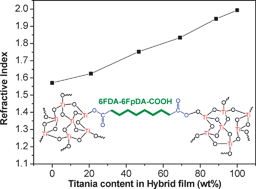In this study, a new synthetic route was developed to prepare polyimide–nanocrystalline-titania hybrid materials with a relatively high titania content (up to 90 wt%). A soluble polyimide with carboxylic acid end groups (6FDA–6FpDA–COOH) was first synthesized from 4,4′-(hexafluoroisopropylidene) diphthalic anhydride (6FDA), 4,4′-(hexafluoroisopropylidene) dianiline (6FpDA), and 4-aminobenzoic acid (4ABA). Such end groups could undergo an esterification reaction with titanium butoxide and provide organic–inorganic bonding. A homogeneous hybrid solution was obtained through the mole ratio of titanium butoxide/carboxylic acid, water/acid content, and a mixed solvent system. HRTEM and XRD results indicated the formation of nanocrystalline-titania domains of around 3–4 nm in the hybrid films. The spin-coated hybrid films had relatively good surface planarity, high thermal stability, tunable refractive index (1.571 < n < 1.993), and optical transparency in the visible range. The achieved refractive index of 1.943 is the highest among the polymer–titania based hybrid materials as far as we know. A three-layer anti-reflection coating based on the prepared hybrid films was designed and possessed a reflectance of less than 0.5% in the visible range. Our study demonstrates a new route for preparing high refractive index polyimide–nanocrystalline-titania hybrid materials for potential optical applications.

You have access to this article
 Please wait while we load your content...
Something went wrong. Try again?
Please wait while we load your content...
Something went wrong. Try again?


 Please wait while we load your content...
Please wait while we load your content...